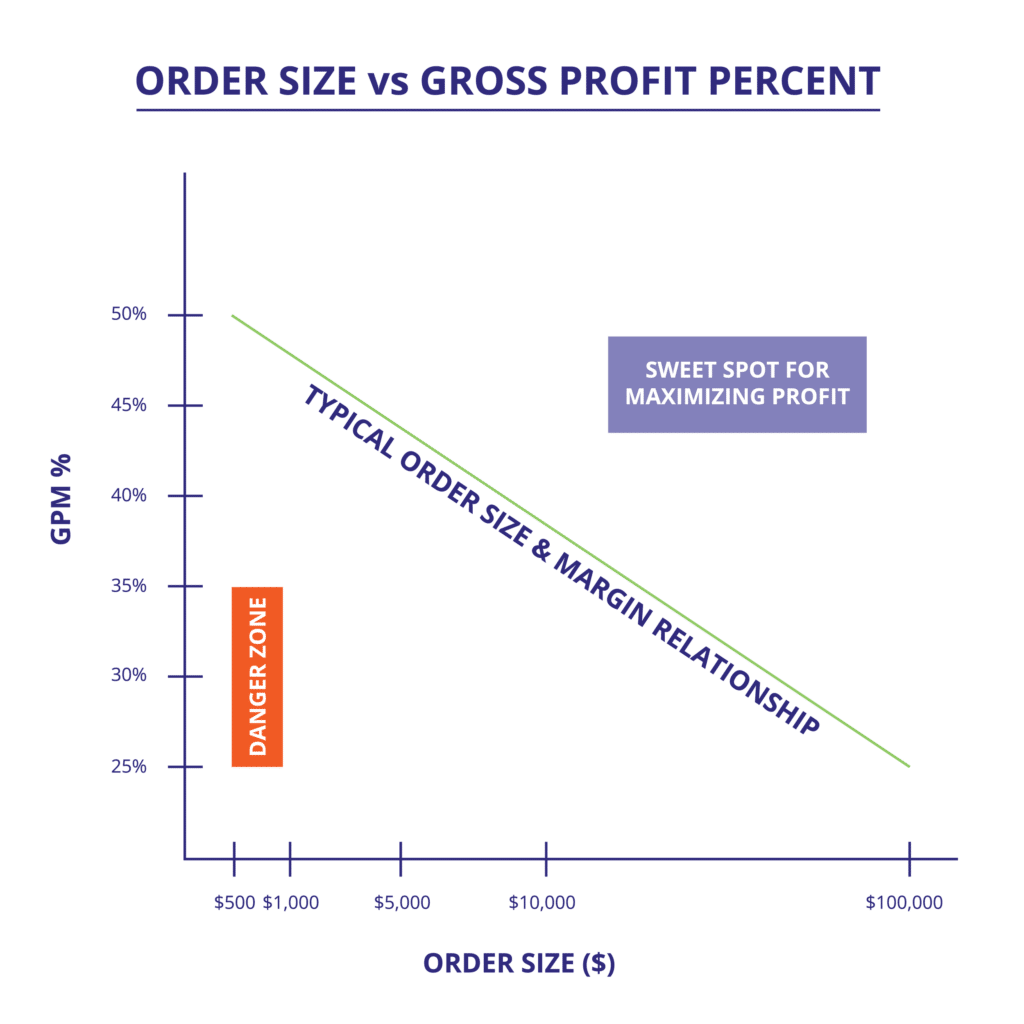Average distributor gross profit margins (GPM) range between 34% – 36%, but I work with many distributors that average 40% – 45%. So, what is their secret and how can you raise your margins?
It mostly comes down to the mindset of the distributor owner that they have passed on to the sales team. If it’s embedded in your sales culture to get 35% margins, then that is what you’ll get. The good news is that changing this mindset isn’t difficult and the benefits include an immediate and long-term increase in profitability.
The first step is to overcome the traditional mindset that says small orders require higher margins and large orders deserve lower margins. The most profitable distributors understand that most of their profit comes from larger orders at higher margins – this is the “sweet spot” for profitability!
Unfortunately, many distributors give back much of their profit by accepting too many small orders with low margins – this is the “danger zone” where profit is often minimal for the rep and negative for the distributor.

Coach your sales team to analyze their client list and focus on growing sales to clients that have higher average order sizes and above average margins. Clients with small average order sizes and low margins likely need to be replaced with better clients. The best orders/clients allow distributors and reps to be aligned when it comes to making profit.
This isn’t just theory – most distributors have recent examples of large orders with high margins. Share these with your sales team and celebrate when reps land an order in your “sweet spot.” This constant reinforcement of your margin strategy will change and maintain the mindset you’re looking for.
What’s Your Differentiator?
Hopefully, low prices aren’t your differentiator as we all understand this is a race to the bottom that most can’t win. Make sure your sales team understands the inherent marketing value of branded merch and your specific differentiators that appeal to buyers. Instill a sense of pride in your company – if you’re telling your clients that you’re the best, then don’t be afraid to charge like it.
Equip your sales team with the talking points to not only overcome price objections, but to clearly justify your price. Buyers need to understand that service, creativity, brand protection, etc., come with a cost.
Being proactive with ideation is a great way to minimize competing on price. If clients send you a product idea they found and ask for a quote, you’re likely in a bidding situation and haven’t added any value to warrant a higher margin. Preempt this situation by understanding your clients’ event dates and making sure you provide creative solutions before they start their own research. Now you are adding value and can justify your price. This is a key differentiator between the best sales reps and order takers – more on this topic down the road.

Randy Conley
President, Promo Consulting
Upselling and cross-selling are two great opportunities to increase margins. Suggesting creative packaging or fulfillment solutions differentiates you from the product sellers and bundling additional value-add products or services into one price makes it more difficult for the client to price shop.
Don’t forget the power of the relationships you’ve forged with your top clients.
- They know, like and trust you and have likely decided that you’re their preferred merch provider.
- If you’re confident you’ll be getting the order, then it’s ok to ask for a fair price that reflects the value you bring to the relationship.
You also can choose your clients, so encourage your sales team to gradually replace “danger zone” clients with new clients that value what you deliver and are willing to pay your price (sweet spot).
Create New Habits
Margins can be increased significantly by gradually changing your rep’s mindset and habits.
Instead of asking to raise margins by 5% right away, ask for a modest 2% increase where possible. Every time you are preparing a quote, pause and ask yourself, “Can I get 2% more margin?” Over time, reps will have success, grow confidence and expand their margins by even more than 2%, and many will take it to the next level on their own and gradually start asking for 3%, 4% or even 5% more, especially from loyal clients.
RELATED: ‘No’ Is The Hardest Word: How Lanier Goods Has Grown 1,400% Since 2020
Establish a new company margin goal (40%?) and a minimum required margin for each order (35%?). Most industry specific ERP systems allow commission structures that automate this process. Ask reps who feel a need to quote below your minimum margin to review the project with you in advance as there may be situations where lower margins are justified.
- This quick review meeting allows you to coach the rep and determine a margin strategy that works for both the rep and the company.
New habits will be gradually created over what is typically a three-month period. Have an over-the-top focus provided by significant internal marketing. Share “sweet spot” orders via a daily team email. During every sales meeting, shout out reps who are taking actions to replace small clients/orders with larger clients/orders. Run an incentive contest and reward the rep with the highest margin each week until new habits are formed.
Don’t let reps forget about asking for just 2% more margin to create a company sales culture of winning with higher margins.
As an entrepreneur with over 40 years of promo experience, Randy Conley has built his own successful distributorship, been an executive at a leading industry SaaS provider and worked with some of the top distributors in the industry as a consultant. He’s currently president of Promo Consulting, which is focused on helping distributors do better.


